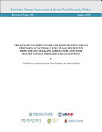Identifying priority value chains in Tanzania
Thurlow, James · Randriamamonjy, Josée · Benson, Todd
Aug 2018 · Feed the Future Innovation Lab for Food Security Policy Research Paper Book 106 · Intl Food Policy Res Inst
Ebook
20
Pages
family_home
Eligible
info
reportRatings and reviews aren’t verified Learn More
About this ebook
Value chain development is increasingly perceived as an important approach for agricultural development in developing countries. This paper uses a Rural Investment and Policy Analysis (RIAPA) model for the mainland Tanzania economy to identify the agricultural activities and value-chains whose expansion will be most effective at fostering economic development along four dimensions: generating economic growth in the agricultural-food sector of Tanzania; reducing national and rural poverty; generating employment; and improving nutrition by diversifying diets. The results of scenarios run through the model suggests that there is no single value-chain that can achieve all of the policy objectives. Instead, a more balanced portfolio of value-chains would not only enhance agriculture’s future contribution to poverty reduction and economic growth, but also promote faster rural transformation and dietary diversification, both of which are needed to create job opportunities and improve nutrition outcomes over the longer-term. The analysis suggests that vegetables, coffee, milk, cotton, nuts, and oilseeds should be considered as “priority” value-chains, because these are the most effective at achieving multiple policy objectives. Other value-chains that meet several of the development objectives considered include maize, fishing, wheat and barley, rice, cattle, and poultry and eggs.
Rate this ebook
Tell us what you think.
Reading information
Smartphones and tablets
Install the Google Play Books app for Android and iPad/iPhone. It syncs automatically with your account and allows you to read online or offline wherever you are.
Laptops and computers
You can listen to audiobooks purchased on Google Play using your computer's web browser.
eReaders and other devices
To read on e-ink devices like Kobo eReaders, you'll need to download a file and transfer it to your device. Follow the detailed Help Center instructions to transfer the files to supported eReaders.








